
| Specifications |
| Publisher: Sterling Publishers Pvt. Ltd. | |
| Author: Jess E. Dines | |
| Language: English | |
| Pages: 120 | |
| Cover: Paperback | |
| 8.5 inch x 5.5 inch | |
| Weight 160 gm | |
| Edition: 2021 | |
| ISBN: 9788120714694 | |
| NAE706 |
| Delivery and Return Policies |
| Ships in 1-3 days | |
| Returns and Exchanges accepted within 7 days | |
| Free Delivery |
Unfortunately, many associate graphology ( handwriting analysis ) with palm reading, fortune telling, ESP, astrolgoy and the occult. Go to any book store and try to buy a book on graphology. Most won't ever have any in stock and those that do, store them in one of the aforementioned sections.
Although it has been in existence as far back as the Egyptian Empre, its real recognition and usefullness is about 100 years old and is considered to be a science by Western countries, mostly by europeans. Yet more and more it is being fully recognized in the U.S.A as can be evidenced by its use in the large corporations when hiring people and those in the police, penal, legal and education profession, just to mention a few.
This book is written to "spread the gospel" about graphology in order for all of us to enjoy and take advantage of its usefullness. The more of us that take a decided interest in it, the more its accpetance.
Painstaking efforts were made to take the complexity out of this science (and complex it is) so that we can all understand and learn it and apply it to personal and practical use.
Why This Book?
There have been many books written on handwriting analysis (graphology), mostly categorically and usually consisting of hundreds of pages, laboriously explaining its intricate details. Specifically, this book is' a simplified version designed for all, including the business person and professional who will find it an invaluable tool and a must. Such people are not likely to have the time or inclination to study and understand the full essence of graphology, especially if there is a great deal of complex reading material. Thus, this book is designed to give one a quick "thumb-nail" sketch of certain pertinent traits to look for in one's handwriting, such as drive, ambition, honesty / dishonesty, intelligence, leader- ship, best type of job one would be happy or suited for, how well one gets along with others, how good a manager one is, etc. Obviously, understanding solely the contents of this book will not make you a graphologist in the wildest of one's imagination, rather it serves to give you an "idea" or "feel" about someone in the fastest possible and most accurate way. To become a proficient or master graphologist takes many years of training.
In the analysis, keep in mind that anyone's particular trait is not one that necessarily occurs 100% of the time. For example, a person who is considered frugal may only be so say 70% of the time, whereas 30% of the time one may in fact be relatively generous to others. Actually such percentages may even vary continuously. So when certain traits are identified, it simply implies that they occur for the majority of the time.
Also, trait evaluation cannot be limited alone to skills and abilities but also to personality. One can be the most responsible, honest, adept person in existence, but coupled with a negative, abusive and critical personality such a person cannot coexist peacefully with others and keep "harmony" in a team-concept establishment. For example, a highly-skilled moody and depressed worker is usually counter- productive in a company because of his demoralizing effect on others.
Specifically this book is for the entrepreneur, executive, manager, supervisor, politician, and those involved in police, education, legal, medical and penal work. Also, included are those who are in purchasing, sales, engineering, personnel, credit and collections (e.g., is one a good risk?), accounting, bookkeeping, and all those involved in a leadership role such as in the military or in an academy. In actuality, this book is for everyone since we all want to know more about ourselves and others in personal, friendship and marital relationships.
This analysis is for those who want to know more about people with whom they are dealing, those whom they want to hire or promote, those where agreements and contracts must be signed, those who want to advance or replace others in key or responsible positions, and above all to know themselves better. It is a fact that we tend to forget and block out our bad points and amplify our good ones.
Think of the money saved in wasted training for a person who won't fit the bill. What about the attorney who wants to quickly size up his client? Is he telling the truth? Will he pay the bill? Or the doctor who wants to know if his patient is really ill or is just a hypochondriac. Such an analysis is analagous to going to a psychiatrist and giving him a chart of how you feel at the moment.
Consider, for example, when hiring or meeting someone new. First impressions are through appearance, actions and first words spoken. These can be deceptive as one can readily relate to. Couldn't a reticent, insecure person mask his per- sonality by acting? What about a very intelligent person who is book but not street smart? Many dishonest people can look you straight in the eye and give the illusion of impeccable honesty.
What is Graphology?
Graphology is a complete, accurate examination and evaluation of behavior and personality of one's inner self, as well as others. If people really completely and thoroughly knew and understood each other (impossible!), counseling, psychiatry and psychology would be unnecessary and graphology would only divulge those obvious characteristics already known. Each of us is really three people, that is; one's self-image, the personality projected to everyone else, and a combination of all of these.
It is an inexact science (analagous to meteorology) which obviously is not 100% accurate at all times. This is partly true because our behavior and personality changes daily and even sometimes instantaneously. Thus, an absolute "true" analysis would involve taking many handwriting samples over many months, and the overall results would depend upon such factors as our changing mood, environment, business / living conditions, physical/mental health, etc.
What Does Graphology Do?
It is probably the fastest way one can learn about another's behavior and personality with great accuracy. Other methods are longer, tedious, more nebulous and inaccurate. These include: written, oral and physical tests which cover personality, aptitude, intelligence and muscular coordination and even the Rorschach test.
Graphology can quickly reveal such things as your char- actor, emotions, intellect, creativity, social adjustment, material values, physical/mental disabilities, self-awareness, reliability and physical aptitude, (sports, dancing, sex) just to mention a few.
Certainly humans are complex from the emotional point of view. Thus, in analyzing them, one should not make a sweeping statement, for example, that "one is very emotional" because first of all this is a relative statement. Secondly, one's emotions change from day to day, sometimes even from minute to minute. Emotions, of course, also depend upon other factors such as one's physical being, environment, contact with others, etc. The point is that when we characterize one as having a certain degree of emotion or of any other trait, we speak of it here as one occurring "most of the time."
Why Use Graphology?
Graphology saves you time and money since without its use, performing written and oral tests are very laborious. They are usually given well after the fact, for example, after a person is hired, accepting a new client, or signing a contract. Think of the problems and aggravation created trying to undo such acts. It is easy to jump to wrong conclusions about a stranger after one short meeting, especially if you rely mostly on your initial observations and intuitiveness. Those having undesirable traits are well-equipped and experienced to hide more or less writing movement. It begins with a thought in your brain which is transmitted to a central nervous system and then to your hand and fingers, the latter of which are only the vehicles that put it in writing. Proof of point! During the Vietnam War, many paraplegics who lost both of their hands and arms learned to write by using a pen in their mouths. After several years of practice, this handwriting closely resembled their original one.
Just like fingerprints, no two handwritings are identical. This is true because there are endless types of strokes, sizes, formations, margins, connections, rhythms, loops, uniformity, crossings, slants, angles, pressure, space, capitals, signatures, baselines, and crossing bars which will be discussed in detail.
The following are facts you should know. One cannot tell the age through handwriting although immaturity can be seen regardless of one's chronological age. Also one cannot tell one's sex, although some masculine and feminine characteristics can be revealed. Other things that cannot be shown are one's race, religion, natural origin and even if one is left- or right-handed.
A particular trait may come out to be different in different handwritings. For example, a person who writes in a "wavy" fashion can be either nervous, energetic, diplomatic or does not know which direction he is heading in life, or any combination of these. The actual characteristics depend on other aspects of the writing like pressure, slant, size, etc. Furthermore, a certain writing will yield certain characteristics one time and the same writing may yield other characteristics at another time since one's behavior and personality are in a constant state of flux.
The approach of this book is to analyze specific parts of the writing like letters and words, and then concluding what the" over-all" signifies. It is like putting pieces of a jig-saw puzzle together.
How To Use This Book
For any particular category (such as zones, slants, pres- sure, and size) you will find many descriptive words associated with it. Simply read these to get a "feel" or "overall picture" of the kind of person being described. Do not dwell on only one or a few of these words.
In fact, some of these may even appear to be contradictory or unrelated. For example, one who writes small may be meticulous, restrained, modest, thrifty, reticent or reluctant just to mention a few of the traits. It is possible but unlikely that one would possess all of these. Yet if the same person also writes to the left possessing such traits as: being introverted, non-communicative, insensitive, inhibited, defiant, insecure, independent, we begin to see a picture of the narrowing down and minimizing the others as to what traits this person really has by" combining" those similar traits. Further combining still other traits will narrow it down even further, zeroing in to final conclusions as to this person's character and personality.
Some traits can simultaneously exist for different aspects of handwriting (there's an overlap). For example, writing to the left as well as the suppression of the lower zone could have the same traits offer, defiance, introversion and repression. Either one of these aspects usually has the same traits. Having both means "more so"; one alone means there is only a "tendency," but not necessarily.
The Handwriting Sample
The more you can get of a handwriting sample, the better. For a quick but not necessarily a very accurate picture, even a small sample on scrap paper (avoid napkins if possible) might do. A pen or pencil will suffice, although the former is preferable. Two or more pages of 8 x 11 unlined paper is ideal, although more often than not you will have to settle for less. If the paper is lined, the writing should be against the lines. If possible, do not tell one that the handwriting is being analyzed since it could be changed intentionally. A void analyzing handwriting on envelopes. A signature must always follow the handwriting sample (but never a signature alone), since this is not nearly enough for a complete fair analysis.
Tell one to write whatever comes into one's mind and in this way you could check one's creativity and intelligence among other things. Such sentences as "Yippee! I dig the free drinks," is very revealing through the use of pertinent letters as will be shown. "How," not "what" one writes, is what should be analyzed.
Some people insist on printing instead of writing. Simply indicate that if one can sign one's name (we all can sign checks, hopefully), then one can write instead of print. Look for slant, size, speed, pressure, capital and small letters, line of writing, beginning and ending strokes, style, margins and signature.
Also, since some people write dit Terently at dit Terenl times, then their analysis also differs at these times.
If you know the person being analyzed, try not to pre. judge his traits. You could be wrong. Several analyses may be necessary since one changes his writing depending upon how he feels physicaUy and mentaUy at the moment.
| Introduction | 7 | |
| 1 | Slant | 15 |
| 2 | Size of Script | 19 |
| 3 | Spacing (Between Words, Lines and Letters) | 21 |
| 4 | Zones | 25 |
| 5 | Pressure | 29 |
| 6 | General Types | 31 |
| B | Garland | 31 |
| C | Arcade | 31 |
| D | Angular | 32 |
| E | Threaded | 33 |
| 7 | Individual Letters | 35 |
| A | Capitals | 35 |
| B | Capital Letter "I" | 36 |
| C | The Small Letter "i" (also "j") | 37 |
| D | The Letter "t" | 38 |
| E | Going Through The Rest Of The Alphabet (Small Letters) | 41 |
| F | Loops | 45 |
| G | Extra Strokes | 46 |
| H | Knots, Hooks, and Claws | 47 |
| 8 | Signature | 49 |
| 9 | Honesty And Dishonesty | 55 |
| 10 | Intelligence | 59 |
| 11 | Leadership | 61 |
| 12 | Other Characteristics | 63 |
| A | Organization | 63 |
| B | Printed Script | 64 |
| C | Speed of Writing | 64 |
| D | Margins | 65 |
| E | Connects and Disconnects | 66 |
| F | Line Slants | 67 |
| 13 | Now You Can Analyse | 69 |
| 14 | Examples | 75 |
| 15 | The Job Interview: Hiring and | 79 |
| Choosing Careers By The Numbers | ||
| A | The Employee | 79 |
| B | The Interview | 79 |
| C | The Interviewer | 80 |
| D | The Application | 81 |
| E | The Three Main Traits To Look For | 82 |
| F | The Job That Fits You And Which You Would Enjoy The Most | 85 |
| G | Careers By The Numbers - Categories | 86 |
| H | Analysis Of Jobs And Professions By Categories | 99 |
| 16 | How to Choose the Right mate lover or Friend | 95 |
| 17 | Health drugs and alcohol | 103 |
| (Graphotherapeutics) | ||
| A | The Drug Addict | 104 |
| B | The Alcoholic | 105 |
| C | Emotional and Mental Disturbances | 106 |
| D | Physical Illness | 108 |
| Change your handwriting change yourself (Graphotherapy) | 113 |
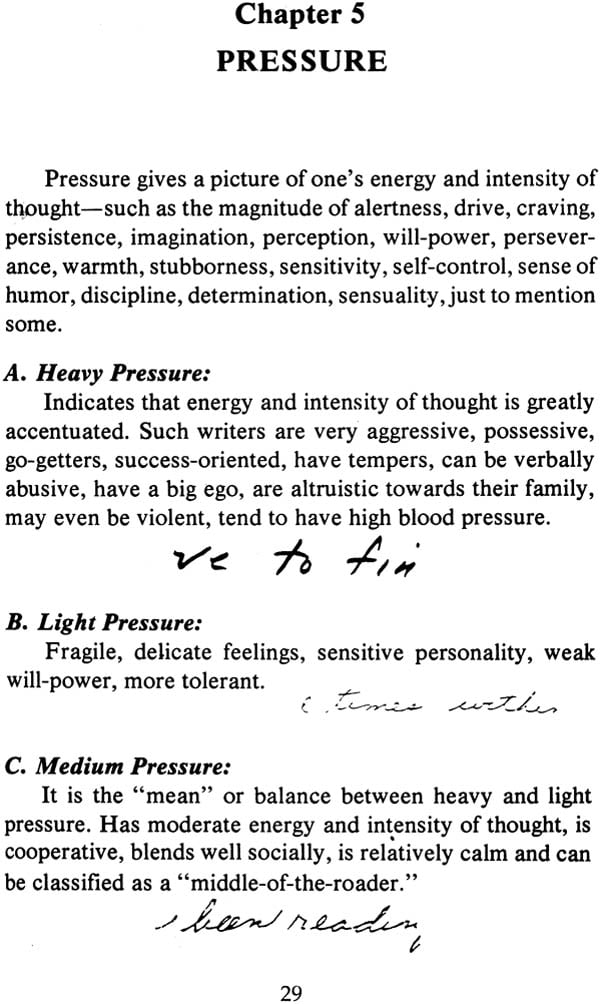
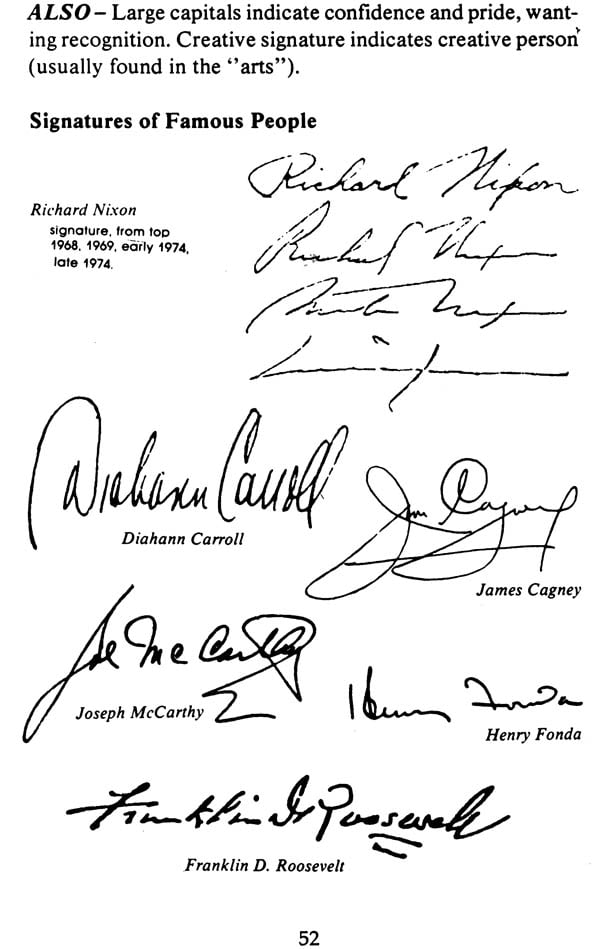

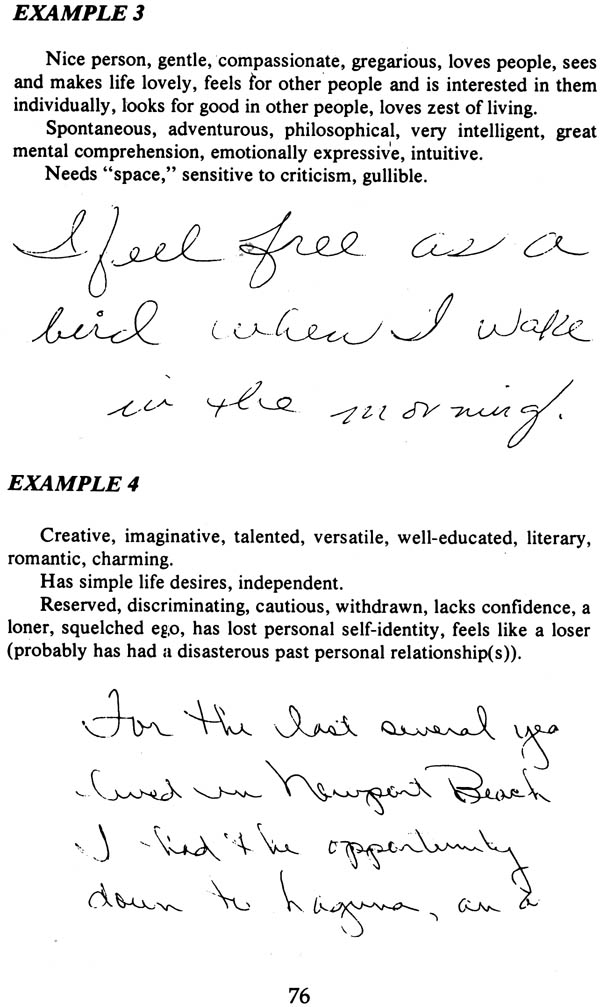
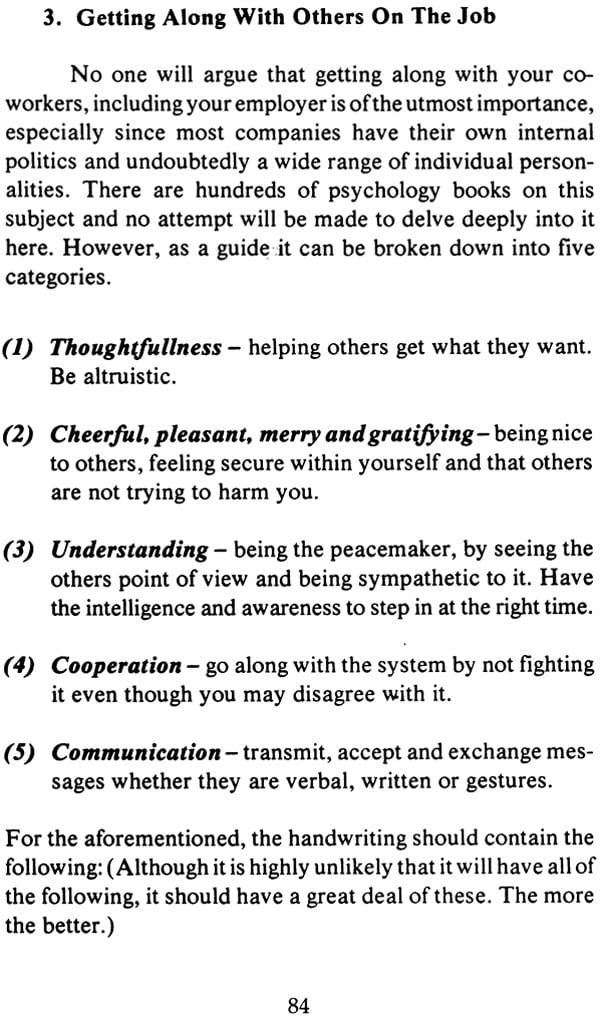
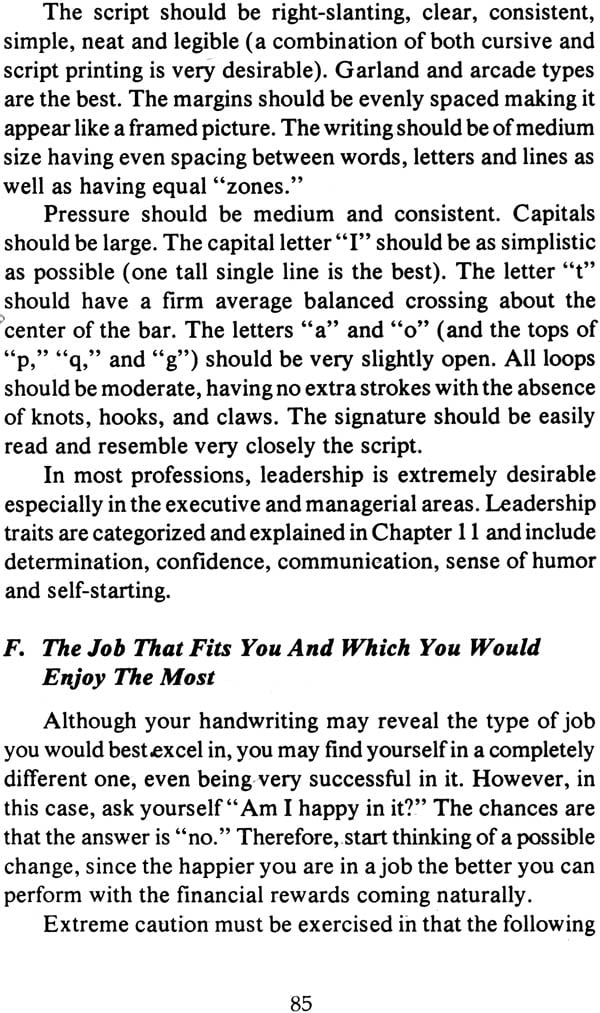
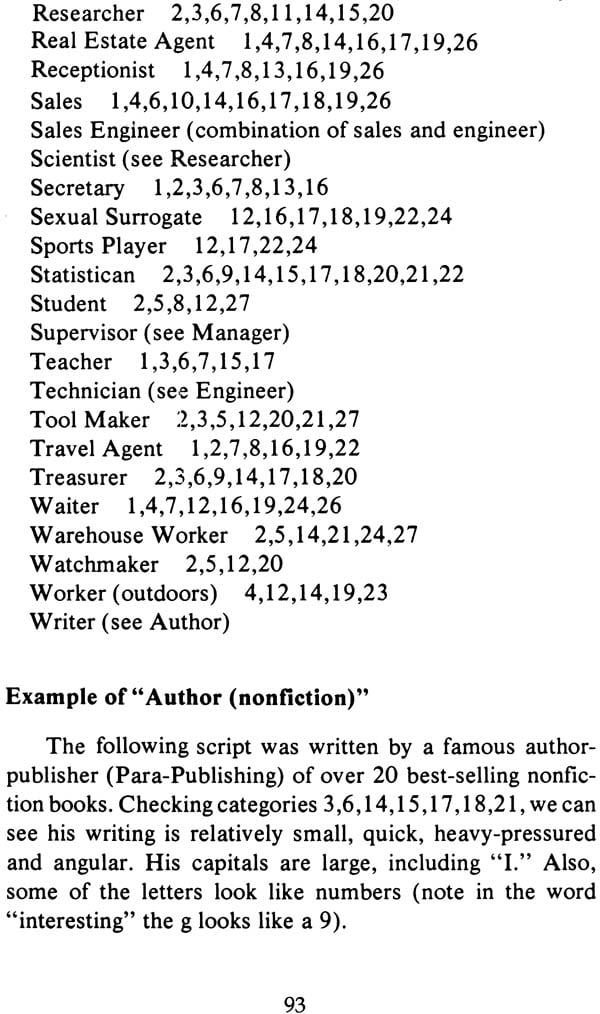
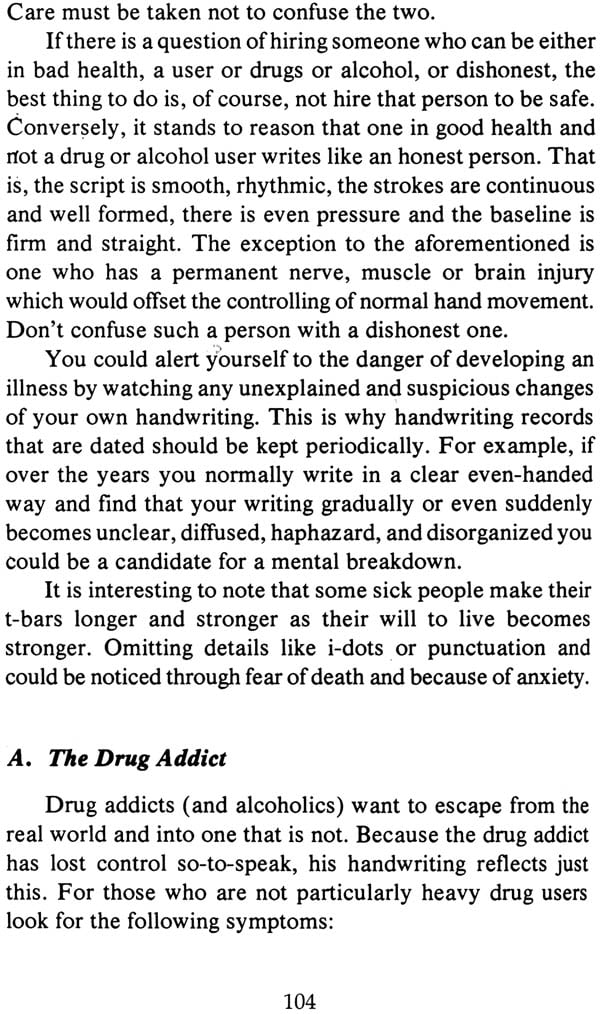


Send as free online greeting card
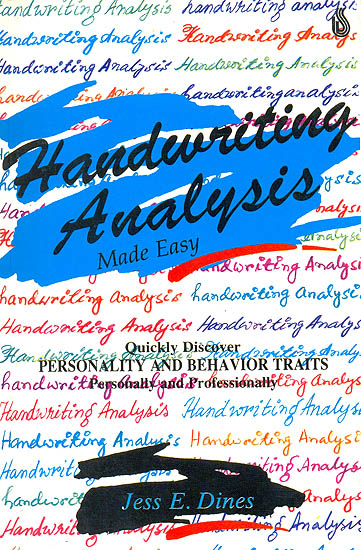
Visual Search